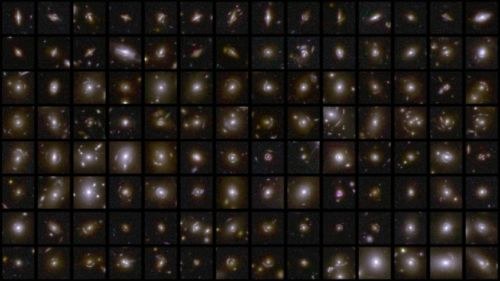Hundreds of thousands of galaxies of different shapes and sizes. The new dataset captured by the European Space Agency’s Euclid mission offers us a glimpse of their large-scale distribution in the cosmic web. The latest observations of the space telescope also include numerous galaxy clusters, active galaxy nuclei, and transient phenomena, as well as the first classification of over 380,000 galaxies and 500 potential gravitational lenses.
After observing three regions of the sky for only one week, Euclid identified 26 million galaxies, at a distance of up to 10.5 billion light-years. In the coming years, these three regions will be observed again dozens of times in order to get a “deep” picture by the end of the mission, planned for 2030.
With its high-resolution imaging visible instrument (VIS), Euclid unveils the huge variety of shapes and the distribution of billions of galaxies very precisely, while its near-infrared instrument (NISP) is essential for unravelling galaxy distances and masses.
The new images confirm these capabilities and provide a view of the large-scale organisation of galaxies in the so-called cosmic web—ordinary matter and dark matter filaments that weave through the cosmos and from which the galaxies have formed and evolved. This is a crucial element for the understanding of dark matter and dark energy, which together appear to make up 95% of the Universe.
During the mission, Euclid is expected to capture images of more than 1.5 billion galaxies, sending back about 100 GB of data every day—an immense dataset that creates incredible discovery opportunities, but also huge challenges when it comes to searching for, analysing, and cataloguing galaxies. In this regard, the progress of artificial intelligence algorithms, combined with thousands of volunteers and scientific experts, is playing a crucial role.
A major milestone in this effort comes from the collaborative work of 9,976 volunteers and the Zoobot artificial intelligence algorithm. Volunteers collaborated in the classification of Euclid images, training Zoobot to recognise the features of different galaxies. This has led to the creation of a detailed catalogue of more than 380,000 galaxies, classified according to features such as spiral arms, central bars and the presence of “tails” that identify galaxies in collision with each other.
This first catalogue, released today, represents only 0.4% of the total number of galaxies of similar resolution that will be imaged during Euclid's mission. The final catalogue will present the detailed morphology of at least an order of magnitude more galaxies than ever measured before. This huge amount of information will help scientists shed light on unresolved questions such as the formation of spiral arms of galaxies or the growth of supermassive black holes.
Thanks to the collaboration between artificial intelligence models, volunteers and experts, a first catalogue of 500 potential strong gravitational lenses, almost all unknown until now, was released. This type of lensing occurs when a foreground galaxy and its halo of dark matter act as a lens, distorting the image of a background galaxy along Euclid’s line of observation.
The path of the light that comes from the distant galaxy is distorted by the normal and dark matter along its path. When distortions are very evident, the phenomenon is known as a “strong lens”. By the end of 2026, Euclid is expected to capture about 7000 potential gravitational lenses, whereas by the end of the mission it is expected to capture approximately 100,000 strong gravitational lenses, about 100 times more than currently known.
Euclid will also be able to measure "weak" gravitational lensing, which is observed when the distortions of the source are much smaller. These subtle distortions can only be detected by analysing a large number of galaxies in a statistical way. In the coming years, Euclid will measure the distorted shapes of billions of galaxies over 10 billion years of cosmic history, thus providing a 3D view of the distribution of dark matter in our Universe.
Euclid, built and operated by the European Space Agency (ESA), was created with the contribution of NASA and the collaboration of the Italian Space Agency (ASI), the Italian National Institute for Astrophysics (INAF), the Italian National Institute of nuclear Physics (INFN), and several Italian universities. The University of Bologna, with its Department of Physics and Astronomy "Augusto Righi" (DIFA), was among the creators and founders of the mission that then led to the development of Euclid. A journey that began in 2007 with the SPACE project (Spectroscopic All-sky Cosmic Explorer), presented by an international team led by Professor Cimatti within the ESA Cosmic Vision 2015-2025 space programme.

